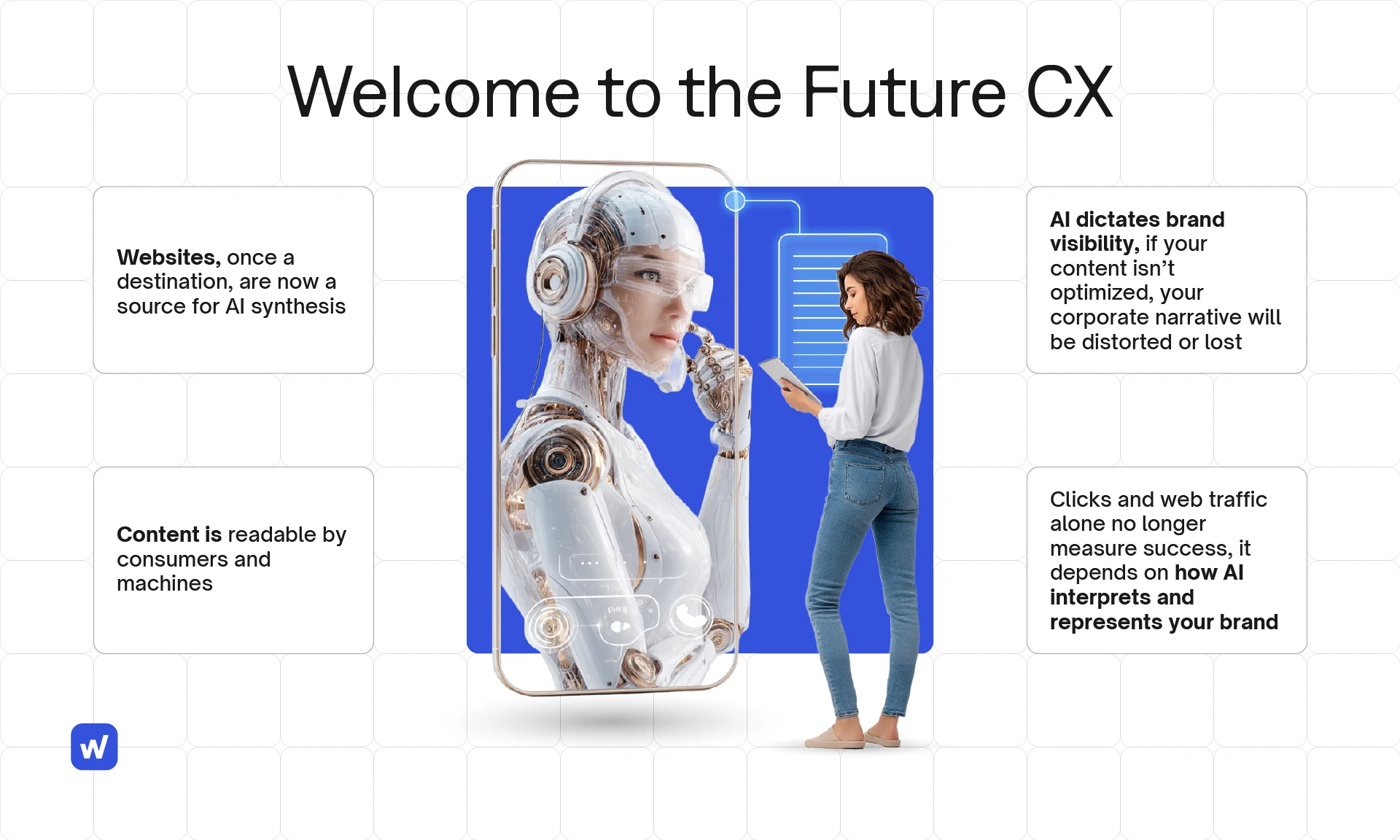Executive Summary
The future is here, machines, not people, are the first to interpret and recommend brands, success is no longer about having a beautiful website. It’s about having content that machines can understand. This article outlines the new imperatives for C-suite leaders to keep their brands visible and trusted in the AI-driven future of customer engagement.


1. You’re Not Just Talking to People Anymore – You’re Talking to Machines
Today, when customers search, shop, or ask questions online, AI systems like ChatGPT, Google’s Search Generative Experience, and Amazon’s Alexa often decide which brands to show them first. These systems analyze your company’s digital content to decide if you’re relevant.
But here’s the catch:
AI can’t “read” in the human sense. It doesn’t scroll your homepage or skim your blog—it scans your content for structure and meaning, like a librarian sorting books using metadata. If your content isn’t clear to machines, your brand is skipped over—even if it’s the best in the market.
2. Let’s Talk About Digital Assets and What They Really Are
Think of your digital assets as everything your customer can touch online:
- Product pages
- Blog posts and FAQs
- Instruction manuals in PDF format
- Social media content
- Videos and their descriptions
- Online reviews
- Third-party listings
If these aren’t optimized in a way that AI systems can understand, they become invisible.
Real-world example:
If a customer asks a chatbot, “What’s a good moisturizer for sensitive skin?” and your product page doesn’t clearly state that your cream is for “sensitive skin,” the AI won’t recommend you—because it doesn’t see that connection.
3. What Does “Semantically Structured” Mean? (And Why Should I Care?)
When we say your content needs to be “semantically structured,” we’re saying it needs to be written and tagged in a way that both humans and machines can understand.
Layman’s analogy:
Think of a grocery store. Products are grouped by type: dairy, bakery, produce. It’s easy to find milk because it’s in the dairy section. Semantically structured content does the same—it tells AI exactly what your “product,” “price,” or “benefit” is, and where to place it.
4. What Is a Knowledge Graph – and Why It’s Your Brand’s Secret Weapon
A Knowledge Graph is like a digital mind map of your brand. It connects:
- Your products
- Your brand values
- Your team
- Your customer reviews
- Your educational content
It helps AI systems form a contextual framework—in other words, it lets machines understand how all your content fits together to form a cohesive story.
Think of it as teaching the AI to understand your brand the way your best salesperson would explain it—only it works at global scale, 24/7.
5. Let’s Demystify the Jargon: A Straightforward Guide for Leaders
| Term | Plain English | Why It Matters |
|---|---|---|
| AI System | Tools like ChatGPT or Google that recommend content to users. | These tools often choose which brands to display. If they don’t understand your content, you’re invisible. |
| Structured Data | Labels in your content that explain what each piece means (e.g., this is a price, this is a product). | It helps AI systems identify your content correctly. |
| Semantic Markup | Adds meaning to the labels. It clarifies the role of the content (e.g., this is a review, not just a sentence). | Gives AI context so it doesn’t misinterpret you. |
| Ontology | A customized dictionary for your industry (e.g., connecting “hydration” with “moisturizer”). | Ensures your products are understood using the right terms. |
| Knowledge Graph | A map that shows how all your content is connected. | Helps AI form a big-picture view of your brand. |
| Internal Link | Smart links between your website pages. | Tells AI which topics are important and how pages are related. |
Together, these turn a regular website into a machine-ready brand asset—one that can be surfaced, recommended, and trusted.
6. Why Business Leaders Must Act Now
This is not just a marketing upgrade—it’s a strategic pivot. If your brand is not properly understood by AI, your content becomes irrelevant in the eyes of the customer—because it never reaches them.
As our CEO, Andrea Volpini, puts it succinctly:
“We are not optimizing pages anymore. We are training machines to understand and represent your brand—at scale.”
7. WordLift: Your Strategic Partner for AI-Ready Brand Growth
WordLift helps enterprise organizations transform their digital content into intelligent assets that machines—and consumers—can trust. Their platform delivers:
- Visibility: Ensures your brand is seen by AI systems everywhere.
- Engagement: Optimizes content to match what customers are looking for.
- Conversion: Powers AI agents that guide users to purchase.
- Thrive: Turns customer interactions into strategy-shaping intelligence.
“At WordLift, we build the infrastructure that lets your content speak fluently to AI. It’s not about traffic anymore—it’s about trust.” — Andrea Volpini
Final Word for the C-Suite
As the digital interface shifts from search bars to intelligent assistants, your brand must evolve from being found to being understood. This shift is already underway. Acting now ensures that your brand continues to lead—not follow—in the age of AI Discovery.
